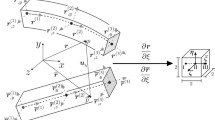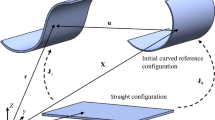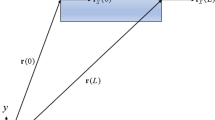Abstract
This paper proposes a new locking alleviation technique for absolute nodal coordinate formulation (ANCF) beam and plate elements based on a strain split approach. The paper also surveys classical finite element (FE) and ANCF locking alleviation techniques discussed in the literature. Because ANCF beam elements, which allow for the cross-sectional stretch fully capture the Poisson effect, Poisson locking is an issue when such beam elements are considered. The two-dimensional fully parameterized ANCF beam element is primarily used in this investigation because such an element can serve as a good surrogate model for three-dimensional ANCF beams and plates as far as membrane, bending and transverse shearing behavior is concerned. In addition to proposing the strain split method (SSM) for ANCF locking alleviation, this work assesses the ANCF element performance in the cases of higher-order interpolation, enhanced assumed strain method, elastic line method, and the enhanced continuum mechanics approach, and demonstrates the design of the enhanced strain interpolation function by using the shape functions of higher-order ANCF elements. Additionally, a new higher-order ANCF two-dimensional beam element is proposed in order to compare its performance with other finite elements that require the use of other locking alleviation techniques proposed and reviewed in the paper. Finally, several numerical examples are shown to demonstrate the effectiveness of the locking alleviation methods applied to ANCF elements. The purpose of this investigation, apart from proposing a new locking alleviation technique, a new higher-order beam element, and comparing several existing locking alleviation techniques, is to show that dealing with locking in fully parameterized ANCF elements is feasible and that several methods exist to effectively improve the ANCF element performance without sacrificing important ANCF element properties and features including position vector gradient continuity. Because of the use of ANCF position vector gradients as nodal coordinates, complex stress-free initially-curved geometries can be systematically obtained. Such initially-curved geometries require special attention when attempting to solve locking problems, as will be discussed in this paper.
Similar content being viewed by others
References
Andelfinger, U., Ramm, E.: EAS-elements for two-dimensional, three-dimensional, plate and shell structures and their equivalence to HR-elements. Int. J. Numer. Methods Eng. 36(8), 1311–1337 (1993)
Armero, F.: On the locking and stability of finite elements in finite deformation plane strain problems. Comput. Struct. 75(3), 261–290 (2000)
Babuska, I., Suri, M.: Locking effects in the finite element approximation of elasticity problems. Numer. Math. 62(1), 439–463 (1992)
Babuska, I., Suri, M.: On locking and robustness in the finite element method. SIAM J. Numer. Anal. 29(5), 1261–1293 (1992)
Bathe, K.J.: The inf-sup condition and its evaluation for mixed finite element methods. Comput. Struct. 79(2), 243–252 (2001)
Bazeley, G.P., Cheung, Y.K., Irons, B.M., Zienkiewicz, O.C. (1965) Triangular elements in plate bending—conforming and nonconforming solutions. In: Proceedings of First Conference on Matrix Methods in Structural Mechanics, Wright-Patterson ATBFB, Ohio
Belytschko, T., Stolarski, H., Liu, W.K., Carpenter, N., Ong, J.S.J.: Stress projection for membrane and shear locking in shell finite elements. Comput. Methods Appl. Mech. Eng. 51(1–3), 221–258 (1985)
Bergan, P.G., Nygard, M.K.: Finite elements with increased freedom in choosing shape functions. Int. J. Numer. Meth. Eng. 20(4), 643–663 (1984)
Bischoff, M., Ramm, E.: Shear deformable shell elements for large strains and rotations. Int. J. Numer. Meth. Eng. 40(23), 4427–4449 (1997)
Bischoff, M., Romero, I.: A generalization of the method of incompatible modes. Int. J. Numer. Methods Eng. 69(9), 1851–1868 (2007)
Bonet, J., Wood, R.D.: Nonlinear Continuum Mechanics for Finite Element Analysis. Cambridge University Press, Cambridge (1997)
Carpenter, N., Belytschko, T., Stolarski, H.: Locking and shear scaling factors in \(C^{0}\) bending elements. Comput. Struct. 22(1), 39–52 (1986)
Choi, J., Lim, J.: General curved beam elements based on the assumed strain fields. Comput. Struct. 55(3), 379–386 (1995)
De Souza Neto, E.A., Peric, D., Owen, D.R.J.: Computational Methods for Plasticity: Theory and Applications. Wiley, West Sussex (2008)
Dmitrochenko, O., Hussein, B.A., Shabana, A.A.: Coupled deformation modes in the large deformation finite element analysis: generalization. ASME J. Comput. Nonlinear Dyn. 4(2), 021002-1–021002-8 (2009)
Dong, S.B., Alpdogan, C., Taciroglu, E.: Much ado about shear correction factors in Timoshenko beam theory. Int. J. Solids Struct. 47(13), 1651–1665 (2010)
Dorfi, H.R., Busby, H.R.: An effective curved composite beam finite element based on the hybrid-mixed formulation. Comput. Struct. 53(1), 43–52 (1994)
Dufva, K.E., Sopanen, J.T., Mikkola, A.M.: A two-dimensional shear deformable beam element based on absolute nodal coordinate formulation. J. Sound Vib. 280(3–5), 719–738 (2005)
Ebel, H., Matikainen, M.K., Hurskainen, V., Mikkola, A.: Higher-order beam elements based on the absolute nodal coordinate formulation for three-dimensional elasticity. Nonlinear Dyn. 88(2), 1075–1091 (2016)
Ebel, H., Matikainen, M.K., Hurskainen, V., Mikkola, A.: Higher-order plate elements for large deformation analysis in multibody applications. In: Proceedings of the ASME 2016 International Design Engineering Technical Conferences & Computers and Information in Engineering Conference, Charlotte, North Carolina, USA, August 21–24 (2016)
Felippa, C.A.: The extended free formulation of finite elements in linear elasticity. ASME J. Appl. Mech. 56(3), 609–616 (1989)
Friedman, Z., Kosmatka, J.B.: An improved two-node Timoshenko beam finite element. Comput. Struct. 47(3), 473–481 (1993)
Garcia-Vallejo, D., Mikkola, A., Escalona, J.L.: A new locking-free shear deformable finite element based on absolute nodal coordinates. Nonlinear Dyn. 50(1), 249–264 (2007)
Gerstmayr, J., Irschik, H.: On the correct representation of bending and axial deformation in the absolute nodal coordinate formulation with an elastic line approach. J. Sound Vib. 318(3), 461–487 (2008)
Gerstmayr, J., Matikainen, M.: Analysis of stress and strain in the absolute nodal coordinate formulation. Mech. Based Des. Struct. Mach. Int. J. 34(4), 409–430 (2006)
Gerstmayr, J., Matikainen, M.K., Mikkola, A.M.: A geometrically exact beam element based on the absolute nodal coordinate formulation. Multibody Sys.Dyn. 20, 359–384 (2008)
Gerstmayr, J., Sugiyama, H., Mikkola, A.: Review on the absolute nodal coordinate formulation for large deformation analysis of multibody systems. ASME J. Comput. Nonlinear Dyn. 8(3), 031016-1–031016-12 (2013)
Hamed, A.M., Jayakumar, P., Letherwood, M.D., Gorsich, D.J., Recuero, A.M., Shabana, A.A.: Ideal compliant joints and integration of computer aided design and analysis. ASME J. Comput. Nonlinear Dyn. 10(2), 021015-1–021015-14 (2015)
Heyliger, P.R., Reddy, J.N.: A higher-order beam finite element for bending and vibration problems. J. Sound Vib. 126(2), 309–326 (1988)
Hughes, T.J.R., Cohen, M., Haroun, M.: Reduced and selective integration techniques in the finite element analysis of plates. Nucl. Eng. Des. 46(1), 203–222 (1978)
Hughes, T.J.R., Taylor, R., Kanoknukulchai, W.: A simple and efficient finite element for plate bending. Int. J. Numer. Methods Eng. 11(10), 1529–1543 (1977)
Hughes, T.J.R.: The Finite Element Method: Linear Static and Dynamic Finite Element Analysis. Prentice Hall, New Jersey (1987)
Hurskainen, V.T., Matikainen, M.K., Wang, J., Mikkola, A.M.: A planar beam finite-element formulation with individually interpolated shear deformation. ASME J. Comput. Nonlinear Dyn. 12(4), 041007-1–041007-8 (2017)
Hussein, B.A., Sugiyama, H., Shabana, A.A.: Coupled deformation modes in the large deformation finite-element analysis: problem definition. ASME J. Comput. Nonlinear Dyn. 2(2), 146–154 (2007)
Ibrahimbegovic, A., Wilson, E.L.: A modified method of incompatible modes. Int. J. Numer. Methods Biomed. Eng. 7(3), 187–194 (1991)
Kerkkanen, K.S., Sopanen, J.T., Mikkola, A.M.: A linear beam finite element based on the absolute nodal coordinate formulation. ASME J. Mech. Des. 127(4), 621–630 (2005)
Kim, J.G., Kim, Y.Y.: A new higher-order hybrid-mixed curved beam element. Int. J. Numer. Methods Eng. 43(5), 925–940 (1998)
Kulkarni, S., Pappalardo, C.M., Shabana, A.A.: Pantograph/catenary contact formulations. ASME J. Vib. Acoust. 139(1), 011010-1–011010-12 (2017)
Lee, P., Sin, H.: Locking-free curved beam element based on curvature. Int. J. Numer. Methods Eng. 37(6), 989–1007 (1994)
Liu, W.K., Belytschko, T., Chen, J.: Nonlinear versions of flexurally superconvergent elements. Comput. Methods Appl. Mech. Eng. 71(3), 241–258 (1988)
Liu, C., Tian, Q., Hu, H.: Dynamics of a large scale rigid-flexible multibody system composed of composite laminated plates. Multibody Sys.Dyn. 26(3), 283–305 (2011)
Malkus, D., Hughes, T.J.R.: Mixed finite element methods—reduced and selective integration techniques: a unification of concepts. Comput. Methods Appl. Mech. Eng. 15(1), 63–81 (1978)
Matikainen, M.K., Dmitrochenko, O., Mikkola, A.: Beam elements with trapezoidal cross section deformation modes based on the absolute nodal coordinate formulation. In: International Conference on Numerical Analysis and Applied Mathematics, Rhodes, Greece, September 19–25 (2010)
Mikkola, A.M., Matikainen, M.K.: Development of elastic forces for a large deformation plate element based on the absolute nodal coordinate formulation. ASME J. Comput. Nonlinear Dyn. 1(2), 103–108 (2006)
Mikkola, A.M., Shabana, A.A.: A non-incremental finite element procedure for the analysis of large deformation of plates and shells in mechanical system applications. Multibody Syst. Dyn. 9(3), 283–309 (2003)
Mohamed, A.N.A., Liu, J.: The three-dimensional gradient deficient beam element (beam9) using the absolute nodal coordinate formulation. In: Proceedings of the ASME 2014 International Design Engineering Technical Conferences & Computers and Information in Engineering Conference, Buffalo, New York, USA, August 17–20 (2014)
Nachbagauer, K.: State of the Art of ANCF elements regarding geometric description, interpolation strategies, definition of elastic forces, validation and locking phenomenon in comparison with proposed beam finite elements. Arch. Comput. Methods Eng. 21(3), 293–319 (2014)
Nachbagauer, K., Gruber, P., Gerstmayr, J.: Structural and continuum mechanics approaches for a 3D shear deformable ANCF beam finite element: application to static and linearized dynamic examples. ASME J. Comput. Nonlinear Dyn. 8(2), 021004-1–021004-7 (2013)
Nachbagauer, K., Gruber, P., Gerstmayr, J.: A 3D shear deformable finite element based on absolute nodal coordinate formulation. Multibody Dyn. Comput. Methods Appl. Sci. 28, 77–96 (2013)
Nachbagauer, K., Pechstein, A.S., Irschik, H., Gerstmayr, J.: A new locking-free formulation for planar, shear deformable, linear and quadratic beam finite elements based on the absolute nodal coordinate formulation. Multibody Syst. Dyn. 26(3), 245–263 (2011)
Noor, A., Peters, J.: Mixed models and reduced/selective integration displacement models for nonlinear analysis of curved beams. Int. J. Numer. Methods Eng. 17(4), 615–631 (1981)
Ogden, R.W.: Nonlinear Elastic Deformations. Ellis Harwood Ltd., Chichester (1984)
Olshevskiy, A., Dmitrochenko, O., Kim, C.W.: Three-dimensional solid brick element using slopes in the absolute nodal coordinate formulation. ASME J. Comput. Nonlinear Dyn. 9(2), 021001-1–021001-10 (2014)
Omar, M.A., Shabana, A.A.: A two-dimensional shear deformable beam for large rotation and deformation problems. J. Sound Vib. 243(3), 565–576 (2001)
Orzechowski, G., Fraczek, J.: Nearly incompressible nonlinear material models in the large deformation analysis of beams using ANCF. Nonlinear Dyn. 82(1), 451–464 (2015)
Orzechowski, G., Shabana, A.A.: Analysis of warping deformation modes using higher-order ANCF beam element. J. Sound Vib. 363, 428–445 (2016)
Pappalardo, C.M., Wallin, M., Shabana, A.A.: A new ANCF/CRBF fully-parameterized plate finite element. ASME J. Comput. Nonlinear Dyn. 12(3), 031008-1–031008-13 (2017)
Pappalardo, C.M., Yu, Z., Zhang, X., Shabana, A.A.: Rational ANCF thin plate finite element. ASME J. Comput. Nonlinear Dyn. 11(5), 051009-1–051009-15 (2016)
Patel, M., Orzechowski, G., Tian, Q., Shabana, A.A.: A new multibody system approach for tire modeling using ANCF finite elements. Proc. Inst. Mech. Eng. Park K J. Multibody Dyn. 230(1), 69–84 (2016)
Pian, T.H.H.: Finite elements based on consistently assumed stresses and displacements. Finite Elem. Anal. Des. 1(2), 131–140 (1985)
Pian, T.H.H., Sumihara, K.: Rational approach for assumed stress finite elements. Int. J. Numer. Methods Eng. 20(9), 1685–1695 (1984)
Prathap, G., Babu, R.: Field-consistent strain interpolations for the quadratic shear flexible beam element. Int. J. Numer. Methods Eng. 23(11), 1973–1984 (1986)
Prathap, G., Babu, R.: An isoparametric quadratic thick curved beam element. Int. J. Numer. Methods Eng. 23(9), 1583–1600 (1984)
Prathap, G., Bhashyam, G.R.: Reduced integration and the shear-flexible beam element. Int. J. Numer. Methods Eng. 18(2), 195–210 (1982)
Rakowski, J.: The interpretation of the shear locking in beam elements. Comput. Struct. 37(5), 769–776 (1990)
Rakowski, J.: A critical analysis of quadratic beam finite elements. Int. J. Numer. Methods Eng. 31(5), 949–966 (1991)
Raveendranath, P., Singh, G., Pradhan, B.: A two-noded locking-free shear flexible curved beam element. Int. J. Numer. Methods Eng. 44(2), 265–280 (1999)
Reddy, J.N.: On locking-free shear deformable beam finite elements. Comput. Methods Appl. Mech. Eng. 149(1–4), 113–132 (1997)
Reddy, J.N., Wang, C.M., Lee, K.H.: Relationships between bending solutions of classical and shear deformation beam theories. Int. J. Solids Struct. 34(26), 3373–3384 (1997)
Sanborn, G.G., Choi, J., Choi, J.H.: Curve-induced distortion of polynomial space curves, flat-mapped extension modeling, and their impact on ANCF thin-plate elements. Multibody Syst. Dyn. 26(2), 191–211 (2011)
Sanborn, G.G., Shabana, A.A.: A rational finite element method based on the absolute nodal coordinate formulation. Nonlinear Dyn. 58, 565–572 (2009)
Schwab, A.L., Meijaard, J.P.: Comparison of three-dimensional flexible beam elements for dynamic analysis: finite element method and absolute nodal coordinate formulation. In: Proceedings of ASME International Design Engineering Technical Conferences and Computer and Information in Engineering Conference, Long Beach, CA, September 24–28 (2005)
Schwarze, M., Reese, S.: A reduced integration solid-shell finite element based on the EAS and ANS concept—geometrically linear problems. Int. J. Numer. Methods Eng. 80(10), 1322–1355 (2009)
Shabana, A.A.: Definition of the slopes and the finite element absolute nodal coordinate formulation. Multibody Syst. Dyn. 1(3), 339–348 (1997)
Shabana, A.A.: Computational Continuum Mechanics, 3rd edn. Wiley, Chichester (2018)
Shabana, A.A.: Dynamics of Multibody Systems, 4th edn. Cambridge University Press, Cambridge (2013)
Shen, Z., Li, P., Liu, C., Hu, G.: A finite element beam model including cross-section distortion in the absolute nodal coordinate formulation. Nonlinear Dyn. 77(3), 1019–1033 (2014)
Simo, J.C., Armero, F.: Geometrically non-linear enhanced strain mixed methods and the method of incompatible modes. Int. J. Numer. Methods Eng. 33(7), 1413–1449 (1992)
Simo, J.C., Rifai, M.S.: A class of mixed assumed strain methods and the method of incompatible modes. Int. J. Numer. Methods Eng. 29(8), 1595–1638 (1990)
Simo, J.C., Armero, F., Taylor, R.L.: Improved versions of assumed enhanced strain tri-linear elements for 3D finite deformation problems. Comput. Methods Appl. Mech. Eng. 110(3–4), 359–386 (1993)
Sopanen, J., Mikkola, A.: Studies on the stiffness properties of the absolute nodal coordinate formulation for three-dimensional beams. In: Proceedings Of Design Engineering Technical Conferences & Computers & Information in Engineering Conference, Chicago, Illinois, USA, September 2–6, 2003 (2003)
Stolarski, H., Belytschko, T.: On the equivalence of mode decomposition and mixed finite elements based on the Hellinger–Reissner principle. Part 1: theory. Comput. Methods Appl. Mech. Eng. 58(3), 249–263 (1986)
Stolarski, H., Belytschko, T.: On the equivalence of mode decomposition and mixed finite elements based on the Hellinger–Reissner principle. Part 2: applications. Comput. Methods Appl. Mech. Eng. 58(3), 265–284 (1986)
Stolarski, H., Belytschko, T.: Shear and membrane locking in curved \(C^{0}\) elements. Comput. Methods Appl. Mech. Eng. 41(3), 279–296 (1983)
Stolarski, H., Chen, Y.: Assumed strain formulation for the four-node quadrilateral with improved in-plane bending behavior. Int. J. Numer. Methods Eng. 38(8), 1287–1305 (1995)
Sugiyama, H., Gerstmayr, J., Shabana, A.A.: Deformation modes in the finite element absolute nodal coordinate formulation. J Sound Vib 298(4–5), 1129–1149 (2006)
Sugiyama, H., Koyama, H., Yamashita, H.: Gradient deficient curved beam element using the absolute nodal coordinate formulation. ASME J. Comput. Nonlinear Dyn. 5(2), 021001-1–021001-8 (2010)
Sussman, T., Bathe, K.J.: A finite element formulation for nonlinear incompressible elastic and inelastic analysis. Comput. Struct. 26(1–2), 357–409 (1987)
Sussman, T., Bathe, K.J.: Spurious modes in geometrically nonlinear small displacement finite elements with incompatible modes. Comput. Struct. 140, 14–22 (2014)
Taylor, R.L., Beresford, P.J., Wilson, E.L.: A non-conforming element for stress analysis. Int. J. Numer. Methods Eng. 10(6), 1211–1219 (1976)
Taylor, R.L., Filippou, F.C., Saritas, A., Auricchio, F.: A mixed finite element method for beam and frame problems. Comput. Mech. 31(1), 192–203 (2003)
Tessler, A., Hughes, T.J.R.: An improved treatment of transverse shear in the Mindlin-type four node quadrilateral element. Comput. Methods Appl. Mech. Eng. 39(3), 311–335 (1983)
Timoshenko, S.P.: On the correction for shear of the differential equation for transverse vibrations of prismatic beams. Philos. Mag. 41, 744–746 (1921)
Valkeapää, A.I., Yamashita, H., Jayakumar, P., Sugiyama, H.: On the use of elastic middle surface approach in the large deformation analysis of moderately thick shell structures using absolute nodal coordinate formulation. Nonlinear Dyn. 80(3), 1133–1146 (2015)
Von Dombrowski, S.: Modellierung von Balken bei grossen Verformungen für ein kraftreflektierendes Eingabegerät, Diploma thesis, University Stuttgart & DLR (1997)
Wilson, E.L., Taylor, R.L., Doherty, W.P., Ghaboussi, J.: Incompatible displacement models. In: Fenves, J.S., Perrone, N., Robinson, A.R. (eds.) Numerical and Computer Models in Structural Mechanics, pp. 43–57. Academic Press, New York (1973). https://doi.org/10.1016/B978-0-12-253250-4.50008-7
Wriggers, P., Reese, S.: A note on enhanced strain methods for large deformations. Comput. Methods Appl. Mech. Eng. 135(3–4), 201–209 (1996)
Yakoub, R.Y., Shabana, A.A.: Three-dimensional absolute nodal coordinate formulation for beam elements: implementation and applications. ASME J. Mech. Des. 123(4), 614–621 (2001)
Yamashita, H., Valkeapää, A.I., Jayakumar, P., Sugiyama, H.: Continuum mechanics based bilinear shear deformable shell element using the absolute nodal coordinate formulation. ASME. J. Comput. Nonlinear Dyn. 10(5), 051012-1–051012-9 (2015)
Yunhua, L.: Explanation and elimination of shear locking and membrane locking with field consistence approach. Comput. Methods Appl. Mech. Eng. 162(1–4), 249–269 (1998)
Zheng, Y., Shabana, A.A.: A two-dimensional shear deformable ANCF consistent rotation-based formulation beam element. Nonlinear Dyn. 87(2), 1031–1043 (2017)
Zienkiewicz, O.C., Owen, D.R.J., Lee, K.N.: Least square-finite element for elasto-static problems. Use of ‘reduced’ integration. Int. J. Numer. Methods Eng. 8(2), 341–358 (1974)
Zienkiewicz, O.C., Taylor, R., Too, J.M.: Reduced integration technique in general analysis of plates and shells. Int. J. Numer. Methods Eng. 3(2), 275–290 (1971)
Author information
Authors and Affiliations
Corresponding author
Rights and permissions
About this article
Cite this article
Patel, M., Shabana, A.A. Locking alleviation in the large displacement analysis of beam elements: the strain split method. Acta Mech 229, 2923–2946 (2018). https://doi.org/10.1007/s00707-018-2131-5
Received:
Revised:
Published:
Issue Date:
DOI: https://doi.org/10.1007/s00707-018-2131-5




